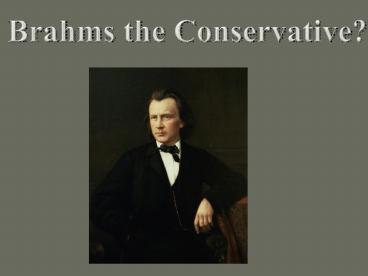In the music of these past masters, the conservative. Brahm - PowerPoint PPT Presentation
1 / 20
Title:
In the music of these past masters, the conservative. Brahm
Description:
In the music of these past masters, the conservative. Brahms sought inspiration. ... lack of program music. Brahms did not give free reign to his musical imagination ... – PowerPoint PPT presentation
Number of Views:147
Avg rating:3.0/5.0
Title: In the music of these past masters, the conservative. Brahm
1
Brahms the Conservative?
2
Franz Liszt, Dance of Death
3
Johannes Brahms, Symphony no. 3 (Poco allegretto)
4
. . . was fed a heavy diet of the great masters,
Bach, Beethoven, and Haydn
. . . the heir apparent to the legacy of Haydn,
Mozart, and Beethoven
. . . again and again Brahms returned to
traditional genres and traditional forms
Vienna was (and remains) a very conservative city
. . . that Brahms should choose it as
his place of residence is not surprising
Brahms was a contrapuntalist, a developer in
the tradition of Bach and Beethoven . . .
Brahms wrote only absolute music. . .
5
I. The Textbook Brahms
A. Brahms the Convervative/Reactionary
B. Brahms the Traditionalist
C. Brahms the Champion of Absolute Music
6
(No Transcript)
7
II. Progressives The New German School
A. Wagner, Liszt and their Circles
B. Organizational Principles
1. Program music
2. leitmotiv
C. NGS Rejects Aesthetics of Autonomous Music
D. Innovations in Harmony and Orchestration
E. Thematic Transformation
8
Thematic Transformation in Liszt, B minor Sonata
embodies progress/evolution
9
III. Brahms the Conservative??
A. Wrote mostly absolute music
B. Employed traditional forms
1. E.g. 4 symphonies
2. All in traditional 4 movements (using
sonata/rondo forms)
C. Wrote lots of chamber music
Esp. string quartets, piano quartets, piano
quintet
D. Harmony largely avoids extreme chromaticism
E. Respect for craft and tradition
F. Preference for minor keys, sombre tone
G. Thick Textures
10
(No Transcript)
11
IV. Brahms the Progressive I
A. Exploration of Rhythm
Hemiola 2 vs. 3 effects
1. Change groupings of even notes
2. Juxtapose compound meter (3s) vs. simple
meter (2s)
12
IV. Brahms the Progressive I
A. Exploration of Rhythm
Hemiola 2 vs. 3 effects
1. Change groupings of even notes
2. Juxtapose compound meter (3s) vs. simple
meter (2s)
13
V. Brahms the Progressive II Brahmss Aesthetics
- 17th-18th Century Music as Representation
- picture theory
B. 19th Century New German School Music
as Expression
-Tied to Representing Outside Reality
a. Paints Picture in Sound
b. If picture is good, listener may feel emotion
14
V. Brahms the Progressive II Brahmss Aesthetics
- 17th-18th Century Music as Representation
- picture theory
B. 19th Century, New German School
Music as Expression
- Tied to Representing Outside Reality
- 19th Century, Brahms
- Aesthetics of Autonomous (Absolute)
Music - 1. Music doesnt mirror outside reality
it - constructs its own reality.
15
Brahms Bottom Line! Traditional FORMS lend
order cohesion But CONTENT (what Brahms trys to
express) progressive
16
- Test Case Brahms, Symphony 4
- (IV, finale)
s t i n a t
O o
A. __ __ __ __ __ __ __ __ bass
- 2 3 4 4 5 1
- 5
B. Unfolds as Variations
C. Large A - B - A shape
17
(No Transcript)
18
(No Transcript)
19
(No Transcript)
20
(No Transcript)































